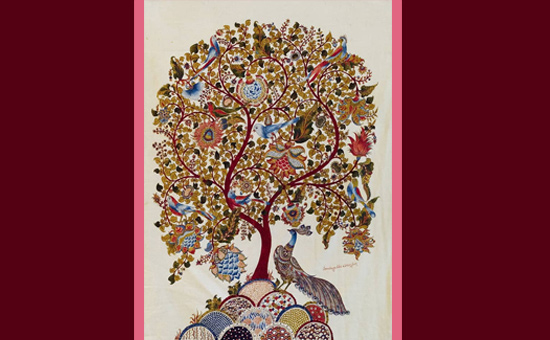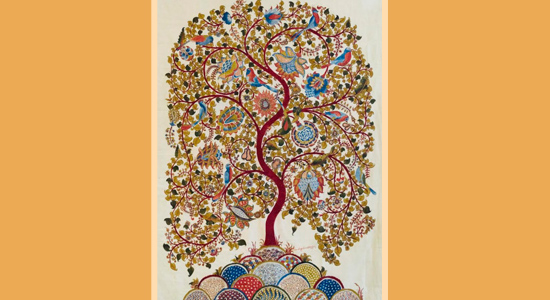- This article tells you about Kalamkari art and technique of making.
From 17th century temples in Andhra Pradesh to stretched canvases in modern homes, Kalamkari is a time-honored and widely beloved form of traditional Indian art. Deriving its name from the word ‘kalam,’ which means pen, ‘Kalamkari’ refers to a particular, intricate style of hand-painting onto cloth and is noted for its beautiful earthy tones.
To me, Kalamkari is a reminder of how art is integral to our sense of fulfillment and wellbeing, how it is synonymous with culture and tradition. I firmly believe that art is unique in its ability to connect us with our humanity and our history—Kalamkari is a distinctly Indian craft, tied to our iconography and mythologies. So, I am excited to share the history, methods, techniques and motifs of Kalamkari painting in this post. There are two types of Kalamkari paintings, Srikalahasti and Machilipatnam, but here I will focus on the freehand drawing Srikalahasti style rather than the Machilipatnam block-printing technique.
 Tree
of Life, Natural dyes on cloth, 54 x 38 inches.
Tree
of Life, Natural dyes on cloth, 54 x 38 inches.
Although even art historians do not know exactly when Kalamkari began, it originated in the modern-day states of Andhra Pradesh and Telangana. Kalamkari was first used to portray scenes from sacred texts such as the Mahabharata, Ramayana and Bhagavatam. These paintings were often used as decorative backdrops in temples, depicting the stories of deities. Today, these subjects are still common in Kalamkari, as well as other spiritual and ancient symbols. The Tree of Life is one especially popular Kalamkari motif, deeply rooted while growing towards the sky—it connects the heavens, earth and underworld. It is also a symbol of nourishment, with many animals feeding on its leaves, living in its branches and enjoying its shade.
Involving up to 23 meticulous steps, the process of creating a Kalamkari painting is as elaborate as the delicate and detailed designs. Before beginning, the artist assembles the following raw materials: cotton cloth, dried unripe fruit and milk to make the ‘mordant,’ charcoal sticks, black kasimi liquid, alum solution and natural pigments in red, indigo and yellow. The Kalamkari paintings technique is outlined below, simplified into broader stages:
● The first step is preparing the cotton to
absorb dyes by washing it to remove starch, sun-drying it fully and treating it
with the mordant as a fixative.
● The artist then sketches the central
figure with charcoal sticks and traces over this outline with a finely pointed
kalam dipped in the kasimi liquid. The kalam is wrapped in wool that holds the
liquid, so the artist squeezes this wool to release the ink while painting.
 Tree of Life, Natural dyes on cloth, 65 x 38 inches.
Tree of Life, Natural dyes on cloth, 65 x 38 inches.
● After the black outline has dried, the
artist can apply a mordant with alum and begin introducing red color to the
cloth.
● After a few more repeats of washing and
drying, the final steps are applying indigo and then yellow dyes to color in
the scene. To produce orange, yellow dye is applied onto red areas, and for
green, indigo is applied to yellow areas.
Overall, this
demanding procedure takes several days as the cloth and ink must fully dry
between each step. But ultimately the time and effort are more than worth it,
as the final colors are strong and exquisite, and the images are captivating in
their depth and complexity. Kalamkari is truly a labor of love for art,
tradition and culture, a joy that is palpable in each painting.
 Tree of Life, Natural dyes on cloth, 57 x 40 inches.
Tree of Life, Natural dyes on cloth, 57 x 40 inches.
Today, it is
difficult to celebrate the rich history of Kalamkari without wondering about
its future. Like many forms of traditional Indian art, Kalamkari is a
generational art, meaning that typically a father or grandfather would train
his children in the family trade. It has been preserved and passed down for
many generations in this way. However today, given the plethora of career
options available to make a steady and more lucrative income, the children of
most Kalamkari artists pursue careers in engineering, business or other fields.
There are only about 16 remaining skilled Kalamkari artists living and working
today, 10 of whom have won National Awards.
At my gallery Laasya
Art based in Palo Alto, California, it is one of my
guiding missions to encourage a new wave of appreciation and support for
traditional Indian craft artists. Kalamkari paintings are held in museums
around the world, from the Victoria and Albert Museum in London to the Museum
of Sydney in Australia, but we need to continue to support living Kalamkari
artists in order to preserve it.
I hope you will
find the same timeless pride and delight in traditional paintings that I have.
DISCLAIMER AND
CREDITS: All images are reproduced here courtesy of the artists and Laasya
Art gallery, Palo Alto. They may not be reproduced elsewhere without
written permission from Laasya Art.